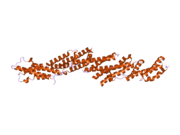EXOC7
| Exocyst complex component 7 | |||||||||||||
|---|---|---|---|---|---|---|---|---|---|---|---|---|---|
 PDB rendering based on 2pft. | |||||||||||||
| |||||||||||||
| Identifiers | |||||||||||||
| Symbols | EXOC7 ; 2-5-3p; EX070; EXO70; EXOC1; Exo70p; YJL085W | ||||||||||||
| External IDs | OMIM: 608163 MGI: 1859270 HomoloGene: 41019 GeneCards: EXOC7 Gene | ||||||||||||
| |||||||||||||
| RNA expression pattern | |||||||||||||
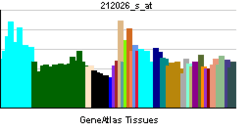 | |||||||||||||
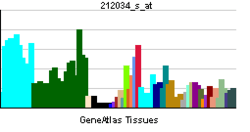 | |||||||||||||
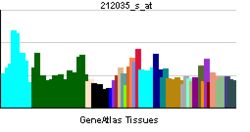 | |||||||||||||
| More reference expression data | |||||||||||||
| Orthologs | |||||||||||||
| Species | Human | Mouse | |||||||||||
| Entrez | 23265 | 53413 | |||||||||||
| Ensembl | ENSG00000182473 | ENSMUSG00000020792 | |||||||||||
| UniProt | Q9UPT5 | O35250 | |||||||||||
| RefSeq (mRNA) | NM_001013839 | NM_001162872 | |||||||||||
| RefSeq (protein) | NP_001013861 | NP_001156344 | |||||||||||
| Location (UCSC) | Chr 17: 74.08 – 74.12 Mb | Chr 11: 116.29 – 116.31 Mb | |||||||||||
| PubMed search | |||||||||||||
| Exo70 exocyst complex subunit | |||||||||
|---|---|---|---|---|---|---|---|---|---|
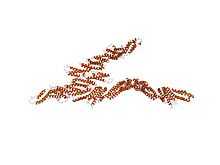 crystal structure of the s. cerevisiae exocyst component exo70p | |||||||||
| Identifiers | |||||||||
| Symbol | Exo70 | ||||||||
| Pfam | PF03081 | ||||||||
| Pfam clan | CL0295 | ||||||||
| InterPro | IPR004140 | ||||||||
| |||||||||
Exocyst complex component 7 is a protein that in humans is encoded by the EXOC7 gene.[1][2] It was formerly known as Exo70.
It forms one subunit of the exocyst complex. First discovered in Saccharomyces cerevisiae, this and other exocyst proteins have been observed in several other eukaryotes, including humans.[3] In S. cerevisiae, the exocyst complex is involved in the late stages of exocytosis, and is localised at the tip of the bud, the major site of exocytosis in yeast.[3] It interacts with the Rho3 GTPase.[4] This interaction mediates one of the three known functions of Rho3 in cell polarity: vesicle docking and fusion with the plasma membrane (the other two functions are regulation of actin polarity and transport of exocytic vesicles from the mother cell to the bud).[5] In humans, the functions of this protein and the exocyst complex are less well characterised: this protein is expressed in several tissues and is thought to also be involved in exocytosis.[6]
Interactions
EXOC7 has been shown to interact with EXOC4[7][8] and RHOQ.[8]
References
- ↑ Strausberg RL, Feingold EA, Grouse LH, Derge JG, Klausner RD, Collins FS et al. (Dec 2002). "Generation and initial analysis of more than 15,000 full-length human and mouse cDNA sequences". Proc Natl Acad Sci U S A 99 (26): 16899–16903. doi:10.1073/pnas.242603899. PMC 139241. PMID 12477932.
- ↑ "Entrez Gene: EXOC7 exocyst complex component 7".
- ↑ 3.0 3.1 TerBush DR, Maurice T, Roth D, Novick P (December 1996). "The Exocyst is a multiprotein complex required for exocytosis in Saccharomyces cerevisiae". EMBO J. 15 (23): 6483–94. PMC 452473. PMID 8978675.
- ↑ Robinson NG, Guo L, Imai J, Toh-E A, Matsui Y, Tamanoi F (May 1999). "Rho3 of Saccharomyces cerevisiae, which regulates the actin cytoskeleton and exocytosis, is a GTPase which interacts with Myo2 and Exo70". Mol. Cell. Biol. 19 (5): 3580–7. PMC 84150. PMID 10207081.
- ↑ Adamo JE, Rossi G, Brennwald P (December 1999). "The Rho GTPase Rho3 has a direct role in exocytosis that is distinct from its role in actin polarity". Mol. Biol. Cell 10 (12): 4121–33. doi:10.1091/mbc.10.12.4121. PMC 25747. PMID 10588647.
- ↑ Kee Y, Yoo JS, Hazuka CD, Peterson KE, Hsu SC, Scheller RH (December 1997). "Subunit structure of the mammalian exocyst complex". Proc. Natl. Acad. Sci. U.S.A. 94 (26): 14438–43. doi:10.1073/pnas.94.26.14438. PMC 25013. PMID 9405631.
- ↑ Sans N, Prybylowski K, Petralia RS, Chang K, Wang YX, Racca C et al. (Jun 2003). "NMDA receptor trafficking through an interaction between PDZ proteins and the exocyst complex". Nat. Cell Biol. 5 (6): 520–530. doi:10.1038/ncb990. PMID 12738960.
- ↑ 8.0 8.1 Inoue M, Chang L, Hwang J, Chiang SH, Saltiel AR (Apr 2003). "The exocyst complex is required for targeting of Glut4 to the plasma membrane by insulin". Nature 422 (6932): 629–633. doi:10.1038/nature01533. PMID 12687004.
Further reading
- Kee Y, Yoo JS, Hazuka CD, Peterson KE, Hsu SC, Scheller RH (1998). "Subunit structure of the mammalian exocyst complex". Proc. Natl. Acad. Sci. U.S.A. 94 (26): 14438–14443. doi:10.1073/pnas.94.26.14438. PMC 25013. PMID 9405631.
- Kikuno R, Nagase T, Ishikawa K, Hirosawa M, Miyajima N, Tanaka A et al. (1999). "Prediction of the coding sequences of unidentified human genes. XIV. The complete sequences of 100 new cDNA clones from brain which code for large proteins in vitro". DNA Res. 6 (3): 197–205. doi:10.1093/dnares/6.3.197. PMID 10470851.
- Soudeyns H, Champagne P, Holloway CL, Silvestri GU, Ringuette N, Samson J et al. (2000). "Transient T cell receptor beta-chain variable region-specific expansions of CD4+ and CD8+ T cells during the early phase of pediatric human immunodeficiency virus infection: characterization of expanded cell populations by T cell receptor phenotyping". J. Infect. Dis. 181 (1): 107–120. doi:10.1086/315181. PMID 10608757.
- Ignatovich O, Tomlinson IM, Popov AV, Brüggemann M, Winter G (2000). "Dominance of intrinsic genetic factors in shaping the human immunoglobulin Vlambda repertoire". J. Mol. Biol. 294 (2): 457–465. doi:10.1006/jmbi.1999.3243. PMID 10610771. Vancouver style error (help)
- Holtmeier W, Hennemann A, Caspary WF (2000). "IgA and IgM V(H) repertoires in human colon: evidence for clonally expanded B cells that are widely disseminated". Gastroenterology 119 (5): 1253–1266. doi:10.1053/gast.2000.20219. PMID 11054383.
- Brymora A, Valova VA, Larsen MR, Roufogalis BD, Robinson PJ (2001). "The brain exocyst complex interacts with RalA in a GTP-dependent manner: identification of a novel mammalian Sec3 gene and a second Sec15 gene". J. Biol. Chem. 276 (32): 29792–29797. doi:10.1074/jbc.C100320200. PMID 11406615.
- Inoue M, Chang L, Hwang J, Chiang SH, Saltiel AR (2003). "The exocyst complex is required for targeting of Glut4 to the plasma membrane by insulin". Nature 422 (6932): 629–633. doi:10.1038/nature01533. PMID 12687004.
- Moskalenko S, Tong C, Rosse C, Mirey G, Formstecher E, Daviet L et al. (2004). "Ral GTPases regulate exocyst assembly through dual subunit interactions". J. Biol. Chem. 278 (51): 51743–51748. doi:10.1074/jbc.M308702200. PMID 14525976.
- Wang S, Liu Y, Adamson CL, Valdez G, Guo W, Hsu SC (2005). "The mammalian exocyst, a complex required for exocytosis, inhibits tubulin polymerization". J. Biol. Chem. 279 (34): 35958–35966. doi:10.1074/jbc.M313778200. PMID 15205466.
- Xu KF, Shen X, Li H, Pacheco-Rodriguez G, Moss J, Vaughan M (2005). "Interaction of BIG2, a brefeldin A-inhibited guanine nucleotide-exchange protein, with exocyst protein Exo70". Proc. Natl. Acad. Sci. U.S.A. 102 (8): 2784–2789. doi:10.1073/pnas.0409871102. PMC 549493. PMID 15705715.
- Rual JF, Venkatesan K, Hao T, Hirozane-Kishikawa T, Dricot A, Li N et al. (2005). "Towards a proteome-scale map of the human protein-protein interaction network". Nature 437 (7062): 1173–1178. doi:10.1038/nature04209. PMID 16189514.
- Beausoleil SA, Villén J, Gerber SA, Rush J, Gygi SP (2006). "A probability-based approach for high-throughput protein phosphorylation analysis and site localization". Nat. Biotechnol. 24 (10): 1285–1292. doi:10.1038/nbt1240. PMID 16964243. Vancouver style error (help)
| |||||||||
This article incorporates text from the public domain Pfam and InterPro IPR004140
